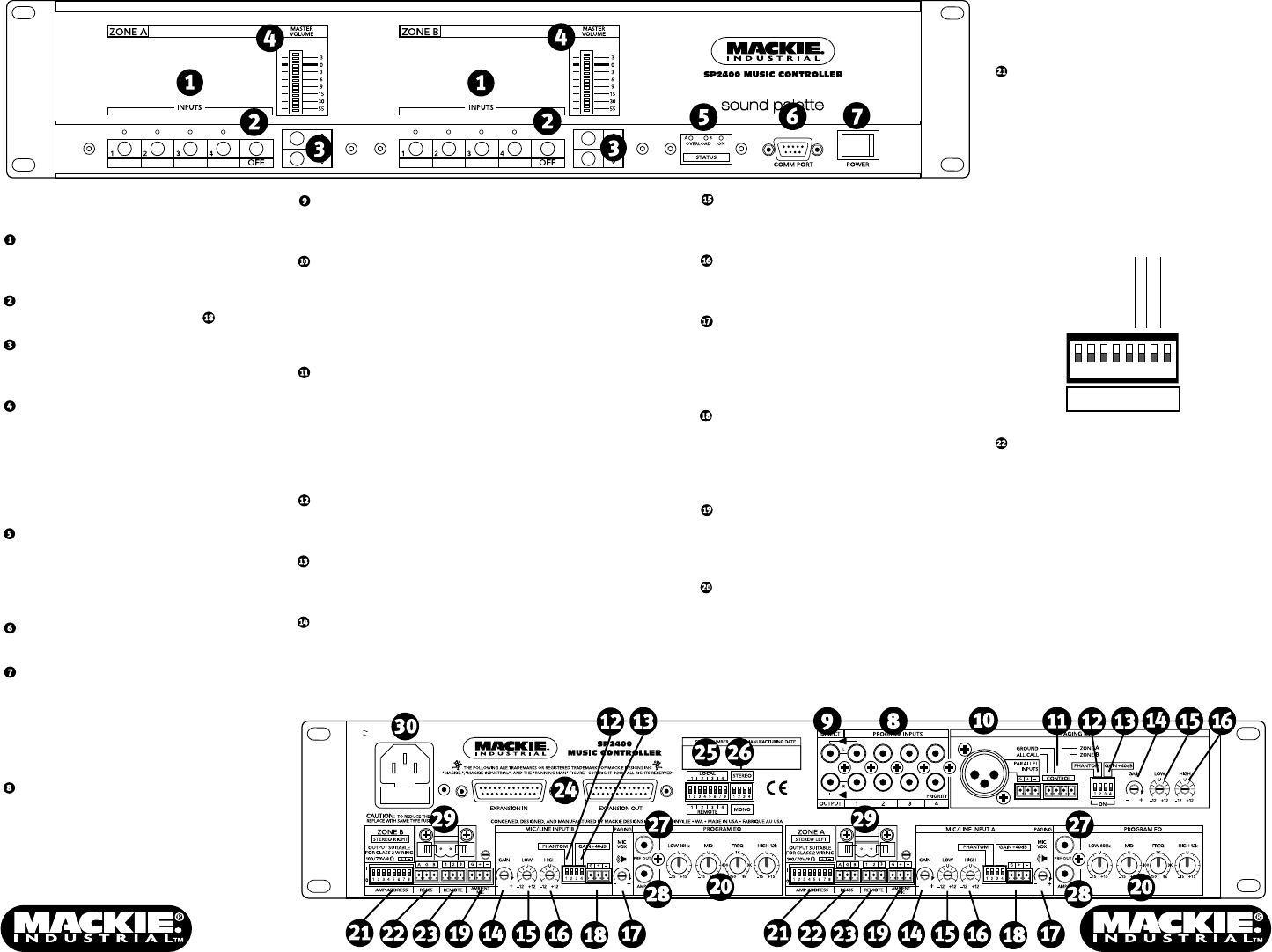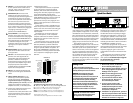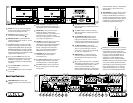
115V 6 0Hz FUSE 115/ T8A 220 WATTS
230V 50Hz FUSE 230/ T4A 220 WATTS
Front Panel Features
INPUTS are used to choose the program
source for its respective zone. Only one
source may be selected at a time.
INPUT OFF deselects Inputs 1-4 and
activates the MIC/LINE INPUT .
MASTER VOLUME is used to adjust the
overall volume level for Inputs 1-4, and for
the MIC/LINE INPUT.
The Meter indicates the level at the PRE
OUT jack. Normally, it operates as a Peak
Program Meter (PPM). When adjusting the
MASTER VOLUME level, the meter changes
to a level-setting meter and indicates the
relative gain setting. It reverts back to PPM
operation after a few seconds.
There are three STATUS indicators. The
OVERLOAD LED indicates when one of the
amplifiers is beginning to current limit.
The ON LED indicates when the SP2400 is
operating.
Use the COMM PORT to configure the
optional DSP card.
Use the POWER switch to turn the SP2400
on and off.
Rear Panel Features
PROGRAM INPUTS are stereo RCA
unbalanced inputs that accept line-level
signals.
DIRECT OUTPUT is a buffered line-level
output providing the stereo signal from
the program source connected to INPUT 1.
PAGING MIC is the connection for the
paging microphone. There are two
connectors available: a 3-pin XLR and a 3-
pin Phoenix-type connector. In both
cases, pin 1 is ground, pin 2 is signal high
(+), and pin 3 is signal low (–).
CONTROL is a Phoenix-type connector for
connecting external normally-open
switches for remote paging. Three options
are available: Page to Zone A, Page to
Zone B, and Page to both Zones (ALL
CALL). Connect the switches between
GROUND and the option of choice.
PHANTOM applies phantom power
(+24VDC) to pins 2 and 3 of the
microphone input.
The GAIN +40 dB DIP switch is used to set
the gain for use with either a mic-level
(+40 dB position) or a line-level signal.
The GAIN variable control is used to trim
the mic preamp gain for the best signal-
to-noise ratio.
The LOW variable control is a shelving
filter that provides 12 dB of boost and cut
below 100Hz.
The HIGH variable control is a shelving
filter that provides 12 dB of boost and cut
above 12kHz.
The PAGING MIC VOX variable control
adjusts the ducking threshold for the
paging mic. Rotate the control clockwise
to reduce the threshold. Rotate the control
counterclockwise to increase the threshold.
The MIC/LINE INPUT is provided to
connect a local microphone in each zone.
This is a 3-pin Phoenix-type connector
where pin 1 is ground, pin 2 is signal high
(+), and pin 3 is signal low (–).
AMBIENT MIC is a 3-pin Phoenix-type
connector used to connect the optional
MT-3100 ambient microphone, one for
each zone.
EQ is a 3-band equalizer with a sweepable
midrange that only affects Inputs 1-4. LOW
is a shelving filter that provides 15 dB of
boost and cut below 80Hz. MID is a
peaking filter that provides 15 dB of boost
and cut at the selected frequency between
250Hz and 8kHz. HIGH is a shelving filter
that provides 15 dB of boost and cut
above 12kHz.
AMP ADDRESS is used to assign a unique
address to each amplifier, as well as to
enable or disable features. Switches 1-5
provide 32 separate addresses, switch 6
determines Master/Slave status, switch 7
enables Input 4 Priority, and switch 8
enables the optional ambient mic.
12345678
0
I
AMP ADDRESS
ZONE
ON
OFF
AMBIENT MIC OFF/ON
INPUT 4 PRIORITY OFF/ON
MASTER/SLAVE
RS485 is a 3-pin Phoenix-type connector
that provides an interface for the SPLinker
Sound Palette Control PC application
software for centralized computer control
for up to 32 zones. The RS485 bus is
internally connected between the two
amplifiers, so if both amplifiers are
assigned the same zone with the AMP
ADDRESS switches, the front panel controls
and remote controls operate both sides.
Additionally, it allows interfacing to third-
party control systems. Pin 1 is the non-
inverting Input/Output, pin 2 is ground,
and pin 3 is the inverting Input/Output.




